STEP 1: Making fermenting liquid
Materials for organic waste compost
A fermentative microorganism is required in order to compost organic waste. These can be obtained from fermented foods. In Japan, these include yoghurt, natto, rice malt, pickles, kimuchi, dry yeast, etc. Fermented foods are also available in many countries. Actinomycete breaks down fibers. Actinomycete can be found in leaf mold. The white bacteria on fallen leaves in forests is actinomycete. Basidiomycete breaks down woody substances, and breaks down the hard fibers in organic waste. Fungus are comprised of clusters of basidiomycete. For this reason, fungus is included here. For safety reasons, commercially available fungus or mushrooms are advised.
Fermented food + sugar water
Produce fermenting liquid. Fermenting liquid is necessary to use fermentative microorganisms efficiently. Now we will explain the method to produce fermenting liquid with fermented foods and sugar water. In order to enable the fermented food bacteria to proliferate, we place them into sugar water. Leaf mold, however, contains contaminant bacteria, so should not be placed in sugar water. The concentration of sugar should be enough for the water to be sweet to the taste. These containers hold fermented foods and mushrooms. Only the stems of the mushrooms are used. There is no specific quantity required. The larger the volume used, the faster the process will be completed. If a small quantity is used, the process will be completed more slowly. The lid is closed once everything has been placed in the container, but since gas is produced by the fermenting liquid, the lid should be loosened. The fermentative microorganism will proliferate in 3-5 days. The measure of success is a sweet-and-sour smell. If the liquid smells clearly bad, the process has failed. Since there is a possibility that bacteria have entered the mix, the sanitation of the fermented food and the water should be confirmed. If water appears to be the cause, the water should be boiled and then cooled, in order to reduce the amount of bacteria.
Vegetables/Fruits + salt water
In countries without fermented foods, fermentative microorganisms can be found on the surface of fruits and vegetables. We will show you how to produce fermenting liquid with vegetables, fruits, and salt water. Locally grown fruit should be used for this. Any leaf or fruiting vegetable (not root vegetables) may be used. The skin of fruits and vegetables contains lactic acid bacteria and yeast, which act to protect the fruit/vegetable from the outside. Root vegetables also carry soil bacteria, so are to be avoided. How to make the mix. Make up salt water. The water should be 1-2% salted, roughly equivalent to the flavor of soup. Leaves and skin from vegetables, as well as the skin of fruits, should be added. There is no need to add the fruits itself. Once everything has been placed in the container it should be closed. Since gas is produced by the fermenting liquid, the lid should be loosened. The fermentative microorganisms will proliferate in 3-5 days. The measure of success is if the mixture smells slightly sour, like a pickle. If it smells like alcohol then the process is complete.
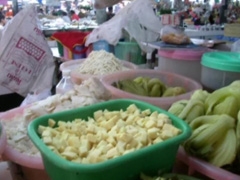
Fermented foods are available in many countries
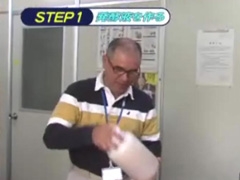
Making fermented liquid
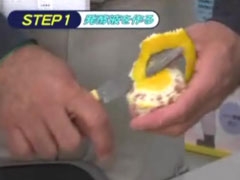
Fermentative microorganisms can be found on the surface of fruits and vegetables
STEP 2: Make fermenting bed
Rice bran and rice husks
Use the fermenting liquid prepared at Step 1 to make fermenting bed necessary for compositing. We will explain the steps. The ideal materials for the fermenting bed are rice bran and rice husks in a ratio of 1:1, but if rice bran is hard to obtain, a ratio of 1:2 or 1:3 is also possible. Since this will make the proliferation of bacteria slower, however, it is best to strengthen the concentration of the fermenting liquid.
Rice straw, fallen leaves, wheat bran, leaf mold, hay, etc.
Rice straw, fallen leaves, wheat bran, leaf mold, hay, etc., can also be used in place of rice husks. Adding around 10% weight of rice bran will promote the proliferation of bacteria. Add the fermenting liquid to the base materials, and mix well. If necessary, add water to maintain an appropriate level of liquid. Add leaf mold if available. If not available, add an additional quantity of fallen leaves.
Adjusting water quantity
The water content of compost should be between 40 and 60%. This is how to adjust the water content. First, take some of the fermenting bed in your hand and squeeze it. The conditions are just right if no water seeps out when the compost is squeezed, and the compost forms a lump when the hand is opened. If the compost does not form a lump when squeezed, and falls apart when the hand is opened, the water content is under 40%. If water flows out between the fingers when the compost is squeezed, the water content is above 60%. It is important that the materials and the fermenting liquid are mixed evenly.
Fermentation
Cover the fermenting bed with breathable fabric to ensure that insects do not get in. The cover can be made from jute bags, newspaper or fabric. Sometimes heat can begin to be generated inside the materials after a day or so. The compost is ready when white bacteria have proliferated across its surface. This takes between three days and a week. If there is less rice bran in the mix, it may take longer, however. This completes the fermenting bed. If this is to be distributed to households, it should be dried for ease of transportation. Once the fermenting bed has been dried, it can be stored for long periods.
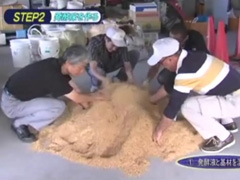
Mixing fermenting liquid to the base materials
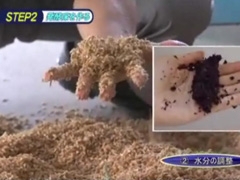
Adjusting water quantity

Cover the fermenting bed
STEP 3: How to use a compost container of organic waste
Finally organic waste will be changed to compost.
A container
A container is required for household compost. Use a breathable container. A shopping basket, bamboo basket, earthenware pot or cardboard box can be used as a container. If the container has large holes in it, it should be lined with carpet, fabric, cardboard etc., in order to prevent spillage or insects from entering the container. Fill the container 60% full with fermenting bed. Cover the bed with newspaper, then use a breathable cover such as fabric, jute or non-woven material.
Adding organic waste
Chop the organic waste finely, place it in the container and mix well. The smaller the waste is chopped, the quicker it will ferment. Squeezing water out of the waste before it is added will also avoid the compost becoming too wet. Mix the compost once per day, to allow air to reach the bacteria. Keep the container covered properly to avoid entering of insects.
Removing the compost
If the breakdown of organic waste has taken place as expected, it should take around 3 months for the container to become full. Once the container is full, part of the compost should be removed. At this point, take care not to remove all the compost from the container. The remaining compost will continue to act as the fermenting bed. This way is efficient because Step1 and 2 can be shortened.
Mature the compost
The compost that has been removed cannot be used as fertilizer immediately. There will be some pieces of organic waste remaining in the compost. These need to be broken down before the compost is used. Remove the compost, and place it in a breathable cardboard box or jute bag. Keep the water content at the same rate as the compost (40-60%) and store for 2 weeks.
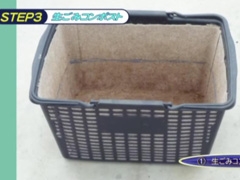
A breathable container
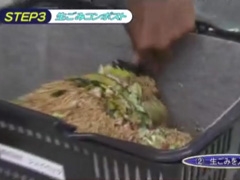
Add organic waste
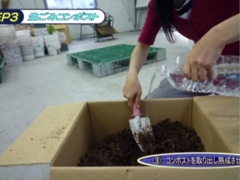
Removing the compost




scroll